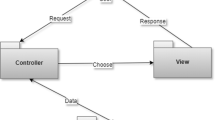Abstract
A key challenge to achieve a unified semantics for UML is how to handle the heterogeneity of its sublanguages. In this context, the theory of institutions provides an elegant and robust framework for programming in the large and in particular for compositionality. It can be used to define a family of formalisms which capture various UML sublanguages, and morphisms that represent the expected semantic relationships between them, resulting in a heterogeneous environment for the semantic definition of UML. The main goal of this work is to collaborate with the definition of such environment. For this purpose, we define an institution for UML 2.0 state machines. The building blocks of our institution are based on a previous semantics dealing with processing simple input events within a transition step. We also extend these semantic definitions for handling sequences of events, and then for considering runs through the state machine.
Similar content being viewed by others
References
von der Beeck M (2002) A structured operational semantics for UML-statecharts. Softw Syst Model 1: 130–141
Calegari D, Szasz N (2011) An institution for UML 2.0 state machines. Tech. Rep. 11-02, InCo-PEDECIBA. http://www.fing.edu.uy/inco/pedeciba/bibpm/ReportesT%e9cnicos
Cengarle MV (1998) The rewriting logic institution. Tech. Rep. Technical Report 9801, Institut für Informatik, Ludwig-Maximilians-Universität
Cengarle MV, Knapp A (2008) An institution for UML 2.0 interactions. Tech. Rep. TUM-I0808, Institut für Informatik, Technische Universität München
Cengarle MV, Knapp A (2008) An institution for UML 2.0 static structures. Tech. Rep. TUM-I0807, Institut für Informatik, Technische Universität München
Cengarle MV, Knapp A, Tarlecki A, Wirsing M (2008) A heterogeneous approach to UML semantics. In: Concurrency, graphs and models. LNCS, vol 5065. Springer, Berlin, pp 383–402
Cîrstea C (2006) An institution of modal logics for coalgebras. J Log Algebr Program 67(1–2): 87–113
Crane ML, Dingel J (2005) On the semantics of UML state machines: categorization and comparison. Tech. Rep. 2005-501. School of Computing, Queen’s University
Czarnecki K, Helsen S (2006) Feature-based survey of model transformation approaches. IBM Syst J 45(3): 621–645
Diaconescu R, Futatsugi K (2002) Logical foundations of CafeOBJ. Theor Comput Sci 285: 289–318
Fecher H, Schönborn J (2007) UML 2.0 state machines: complete formal semantics via core state machines. In: Proceedings of FMICS and PDMC 2006. LNCS, pp 244–260
Goguen JA, Burstall RM (1983) Introducing institutions. In: Logic of Programs. LNCS, vol 164. Springer, Berlin, pp 221–256
Goguen JA, Burstall RM (1992) Institutions: abstract model theory for specification and programming. J ACM 39(1): 95–146
Goguen JA, Rosu G (2002) Institution morphisms. Formal Asp Comput 13(3–5): 274–307
Jin Y, Esser R, Janneck JW (2004) A method for describing the syntax and semantics of UML statecharts. Softw Syst Model 3: 150–163
Lane SM (1998) Categories for the working mathematician 2nd edn Graduate texts in mathematics. Springer, Berlin
Lano K (ed) (2009) UML 2 semantics and applications. Wiley Inc., New York
Mossakowski T (2005) Heterogeneous specification and the heterogeneous tool set. Tech. Rep. Habilitation thesis, Universität Bremen
OMG (2005) Unified modeling language superstructure. formal/2005-07-04 v2.0, Object Management Group
Sannella D, Tarlecki A (2011) Foundations of algebraic specification and formal software development, 1st. edn Monographs. in Theo Comp Sci. Springer, Berlin
Zhan X, Miao H (2004) An approach to formalizing the semantics of UML statecharts. In: Conceptual modeling ER 2004. LNCS, vol 3288. Springer, Berlin, pp 753–765
Author information
Authors and Affiliations
Corresponding author
Rights and permissions
About this article
Cite this article
Calegari, D., Szasz, N. Institutionalising UML 2.0 state machines. Innovations Syst Softw Eng 7, 315–323 (2011). https://doi.org/10.1007/s11334-011-0161-4
Received:
Accepted:
Published:
Issue Date:
DOI: https://doi.org/10.1007/s11334-011-0161-4




